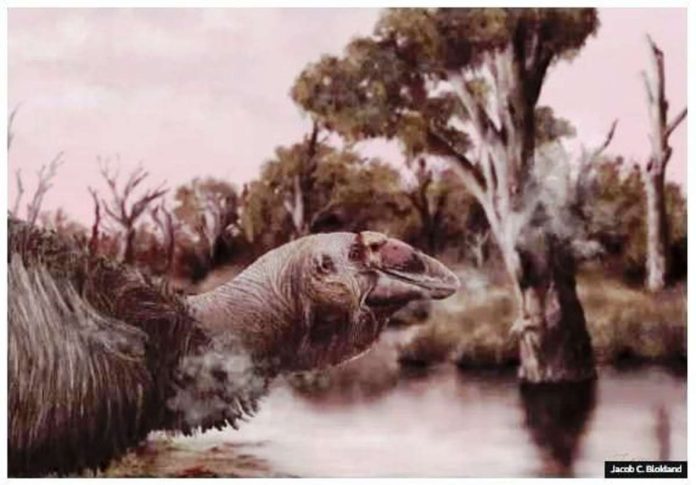
CANBERRA – The skull of a prehistoric “giant goose” has been discovered in Australia.
It belongs to a now extinct giant flightless bird that weighed 230kg – about five times as much as an emu.
The 45,000- to 50,000-year- old fossil is the most complete skull of a Genyornis newtoni to have been discovered.
And researchers say the “stunningly rare find” will give them insight into what the bird looked like.
“Realizing it was an intact skull was just so satisfying,” lead author of the study, in the journal Historical Biology, Dr. Phoebe McInerney, of Flinders University, Adelaide, said. “I thought, ‘Oh my gosh, this is amazing – we actually found one.’
She added: “The Genyornis has been known [about] for 128 years – and now we’ve actually got a skull for it.”
The 32cm skull was found, in 2019, in the dry beds of Lake Callabonnam – a remote region of inland South Australia where thousands of animals once became stuck in the mud – attached to an almost complete fossilized body of the bird.
The only other known skull for this species, reported on in 1913, was heavily damaged and had only a small amount of the original bone, so little could be gleaned from it.
But this latest discovery reveals these giant birds had a massive cranium, large upper and lower jaws, and an unusual casque, like a helmet, on the top of their head.
They also had a wide gape, strong bite and could crush soft plants and fruit on the roof of their mouth.
Genyornis newtoni is a relative of the Australian magpie goose but evolved before them in a separate lineage and is more closely related to the South American screamer species.
Unravelling its relationship to other species had been complex, Dr. McInerney said, but the new find had enabled researchers to start to “piece together the puzzle, which shows, simply put, this species to be a giant goose.”
The last of the large, flightless mihirungs, or thunderbirds, native to Australia, they roamed the outback at the same time as other giant creatures, including lizards and kangaroos, and when the first humans arrived, about 50,000 years ago.
And the size and appearance of this “weird and wonderful” bird would have made it “quite a sight to see,” according to Dr. McInerney.
Jacob Blokland, who has created a scientifically accurate reconstruction of the about two-meter bird, said: “Using modern birds as comparatives, we are able to put flesh back on the fossils and bring them back to life.”
The researchers also discovered the giant birds had many unusual adaptations for aquatic habitats, protecting their ears and throat from water when submerged.
And they said this could have led to their extinction, some 45,000 years ago, as fresh water bodies in northern South Australia were now mostly salt lakes.
Dr. Gerald Mayr, an ornithologist at the Senckenberg Research Institute, Frankfurt, said fossil bird skulls were “stunningly rare” and this “extraordinary find” provided insights into the role the giant bird played within the Australian ecosystem at the time./PN







